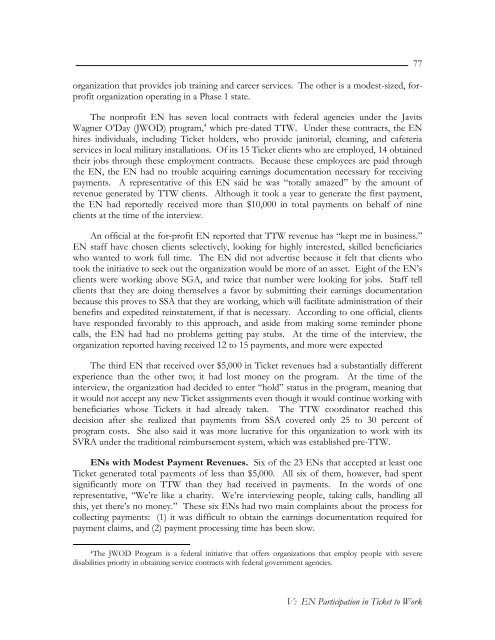Evaluation of the Ticket to Work Program, Implementation ...
Evaluation of the Ticket to Work Program, Implementation ...
Evaluation of the Ticket to Work Program, Implementation ...
You also want an ePaper? Increase the reach of your titles
YUMPU automatically turns print PDFs into web optimized ePapers that Google loves.
organization that provides job training and career services. The o<strong>the</strong>r is a modest-sized, forpr<strong>of</strong>i<strong>to</strong>rganization operating in a Phase 1 state.The nonpr<strong>of</strong>it EN has seven local contracts with federal agencies under <strong>the</strong> JavitsWagner O’Day (JWOD) program, 4 which pre-dated TTW. Under <strong>the</strong>se contracts, <strong>the</strong> ENhires individuals, including <strong>Ticket</strong> holders, who provide jani<strong>to</strong>rial, cleaning, and cafeteriaservices in local military installations. Of its 15 <strong>Ticket</strong> clients who are employed, 14 obtained<strong>the</strong>ir jobs through <strong>the</strong>se employment contracts. Because <strong>the</strong>se employees are paid through<strong>the</strong> EN, <strong>the</strong> EN had no trouble acquiring earnings documentation necessary for receivingpayments. A representative <strong>of</strong> this EN said he was “<strong>to</strong>tally amazed” by <strong>the</strong> amount <strong>of</strong>revenue generated by TTW clients. Although it <strong>to</strong>ok a year <strong>to</strong> generate <strong>the</strong> first payment,<strong>the</strong> EN had reportedly received more than $10,000 in <strong>to</strong>tal payments on behalf <strong>of</strong> nineclients at <strong>the</strong> time <strong>of</strong> <strong>the</strong> interview.An <strong>of</strong>ficial at <strong>the</strong> for-pr<strong>of</strong>it EN reported that TTW revenue has “kept me in business.”EN staff have chosen clients selectively, looking for highly interested, skilled beneficiarieswho wanted <strong>to</strong> work full time. The EN did not advertise because it felt that clients who<strong>to</strong>ok <strong>the</strong> initiative <strong>to</strong> seek out <strong>the</strong> organization would be more <strong>of</strong> an asset. Eight <strong>of</strong> <strong>the</strong> EN’sclients were working above SGA, and twice that number were looking for jobs. Staff tellclients that <strong>the</strong>y are doing <strong>the</strong>mselves a favor by submitting <strong>the</strong>ir earnings documentationbecause this proves <strong>to</strong> SSA that <strong>the</strong>y are working, which will facilitate administration <strong>of</strong> <strong>the</strong>irbenefits and expedited reinstatement, if that is necessary. According <strong>to</strong> one <strong>of</strong>ficial, clientshave responded favorably <strong>to</strong> this approach, and aside from making some reminder phonecalls, <strong>the</strong> EN had had no problems getting pay stubs. At <strong>the</strong> time <strong>of</strong> <strong>the</strong> interview, <strong>the</strong>organization reported having received 12 <strong>to</strong> 15 payments, and more were expectedThe third EN that received over $5,000 in <strong>Ticket</strong> revenues had a substantially differentexperience than <strong>the</strong> o<strong>the</strong>r two; it had lost money on <strong>the</strong> program. At <strong>the</strong> time <strong>of</strong> <strong>the</strong>interview, <strong>the</strong> organization had decided <strong>to</strong> enter “hold” status in <strong>the</strong> program, meaning thatit would not accept any new <strong>Ticket</strong> assignments even though it would continue working withbeneficiaries whose <strong>Ticket</strong>s it had already taken. The TTW coordina<strong>to</strong>r reached thisdecision after she realized that payments from SSA covered only 25 <strong>to</strong> 30 percent <strong>of</strong>program costs. She also said it was more lucrative for this organization <strong>to</strong> work with itsSVRA under <strong>the</strong> traditional reimbursement system, which was established pre-TTW.ENs with Modest Payment Revenues. Six <strong>of</strong> <strong>the</strong> 23 ENs that accepted at least one<strong>Ticket</strong> generated <strong>to</strong>tal payments <strong>of</strong> less than $5,000. All six <strong>of</strong> <strong>the</strong>m, however, had spentsignificantly more on TTW than <strong>the</strong>y had received in payments. In <strong>the</strong> words <strong>of</strong> onerepresentative, “We’re like a charity. We’re interviewing people, taking calls, handling allthis, yet <strong>the</strong>re’s no money.” These six ENs had two main complaints about <strong>the</strong> process forcollecting payments: (1) it was difficult <strong>to</strong> obtain <strong>the</strong> earnings documentation required forpayment claims, and (2) payment processing time has been slow.774 The JWOD <strong>Program</strong> is a federal initiative that <strong>of</strong>fers organizations that employ people with severedisabilities priority in obtaining service contracts with federal government agencies.V: EN Participation in <strong>Ticket</strong> <strong>to</strong> <strong>Work</strong>
















